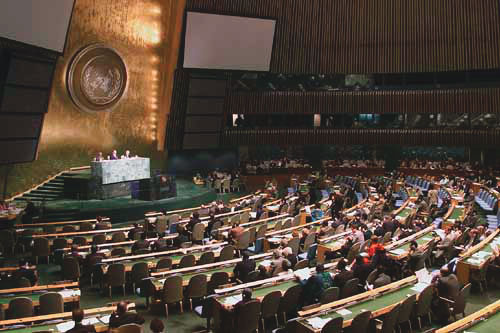Japan's Official Development Assistance White Paper 2005
Main Text > Part I JAPAN'S EFFORTS TOWARD ACHIEVING THE MILLENNIUM DEVELOPMENT GOALS (MDGs) > Chapter 1 Overview of the Millennium Development Goals (MDGs)
Chapter 1 Overview of the Millennium Development Goals ( MDGs )

Prime Minister Koizumi delivering an address at the UN General Assembly, September 2005 (Photo: Cabinet Office)
Key Points
- The MDGs are a synthesis of the United Nations Millennium Declaration and a variety of other past agreements. They consist of eight development goals, including poverty reduction, and stipulate specific numerical targets that must be achieved by the year 2015 deadline.
- 2005 was the first year for review of progress toward achieving the MDGs.
- Progress toward achieving the MDGs can be seen in East Asia, etc., while Sub-Saharan Africa is lagging furthest behind.
The Millennium Development Goals ( MDGs ) were set as common goals and objectives that the entire world must address in the 21st century. There are eight goals in the MDGs, including the eradication of poverty, universal primary education, reduction of child mortality, improvement of maternal health and environmental sustainability, and all of the goals have quantitative objectives and a target date of 2015. Almost all the countries in the world have committed to the MDGs. Progress toward achieving the MDGs is to be reviewed every five years, and the year 2005 was important as it was the first review year. Part I presents an overview of the MDGs and Japan's efforts toward achieving them.

Millennium Summit (Photo: United Nations)
 Establishment of the MDGs
Establishment of the MDGsAt the United Nations Millennium Summit held in New York in September 2000, which was attended by representatives of 189 countries from around the world, the United Nations Millennium Declaration was adopted as the outcome document of the summit. The United Nations Millennium Declaration, which addresses issues such as peace and security, development and poverty, environment, human rights, good governance, and the special needs of Africa, indicates a clear direction of the role of the United Nations in the 21st century. The MDGs are comprised of 8 goals which were set by integrating the above declaration and the various agreements adopted at past major international conferences and summits. 1
 The Content of the MDGs
The Content of the MDGsThe eight MDGs are as follows: (1) eradication of extreme poverty and hunger, (2) achievement of universal primary education, (3) promotion of gender equality and empowerment of women, (4) reduction of child mortality, (5) improvement of maternal health, (6) combat against HIV/AIDS, malaria and other diseases, (7) ensuring environmental sustainability, and (8) establishing global partnerships for development. The MDGs are accompanied by 18 targets and 48 indices for measuring progress in achieving these goals. Together, they represent result-oriented quantitative targets focused on improving people's lives in developing countries. The year 2015 has been set as the target date for achieving the MDGs, with 1990 as the base year.
Japan has played an important role in the process of developing the MDGs. The MDGs are based directly on the International Development Goals ( IDGs ) formulated in the New Development Strategy adopted by the Organisation for Economic Co-operation and Development-Development Assistance Committee ( OECD-DAC ). In the process of developing the IDGs, Japan took the position that quantitative targets should be set in order to measure the outcome of development assistance. In addition, regarding the contents of the development goals, Japan stressed that: (1) the targets should be objective, achievable, and can be accepted by both the donor and the recipient countries; (2) targets should require the self-help efforts (ownership) of the developing countries; and (3) quantitative social targets, such as the reduction of child mortality, should be included in addition to quantitative economic targets. As a result of Japan's efforts, the viewpoints above were reflected in the IDGs and incorporated in the MDGs established by the United Nations. 2
Chart 1. Millennium Development Goals

Chart 2. Millennium Development Goals: Status as of 2004 (1)

Chart 2. Millennium Development Goals: Status as of 2004 (2)

 Progress Toward Achieving the MDGs
Progress Toward Achieving the MDGsAs the MDGs are priority development goals of the international community, all developing countries are urged to mobilize their domestic resources, and donor countries and international agencies are also called upon to extend active support. In order to maintain and strengthen the efforts to achieve the MDGs by the target year of 2015, it is important to conduct periodical assessment of the progress. For this reason, the United Nations has decided to prepare a comprehensive report on progress in implementing the Millennium Declaration (UN Secretary-General Report) every five years from the year 2005. The first UN Secretary-General Report was submitted in March 2005. Based on this report and other documents, progress of every goal is indicated in Chart 2.

Speech by then Prime Minister Mori at the Millennium Summit (Photo: Cabinet Office)
 Special Characteristics of the MDGs and the Approach to Achieving the MDGs
Special Characteristics of the MDGs and the Approach to Achieving the MDGsThe four characteristics of the MDGs are as follows:
The first characteristic of the MDGs is that the MDGs are result-oriented development goals with quantitative objectives and a target date. A look at past development assistance shows that while some achieved a certain degree of results, others did not achieve satisfactory results compared to the amount of assistance provided. At the same time, there was a high pressure to reform the development assistance in developed countries because of decreases in ODA budget due to fiscal constraints, as well as beliefs that assistance was not effective enough. Consequently, this led to a movement to adopt a more result-oriented approach to development assistance, and thus quantitative objectives and target dates were set in the MDGs.
The second characteristic of the MDGs is that the MDGs call for self-help efforts (ownership) of developing countries. In order to enhance aid effectiveness, it is important that developing countries pursue development by self-help efforts (ownership), and that donor countries provide support (partnership). Based on this approach, developing countries are expected to take primary responsibility for their development efforts and to achieve the MDGs, particularly goals 1 to 7.
The third characteristic of the MDGs is that the 8 goals, which are interrelated, approach poverty from various angles and aim for a comprehensive measure to reduce poverty. For example, in order to reduce child mortality and improve maternal health (Goals 4 and 5), health-related measures alone such as providing medicine and fostering medical experts are insufficient. At the same time, the supply of safe drinking water (Goal 7), which contributes to improving the health of children by preventing infant diarrhea and other illnesses, and an improvement in literacy and general health education (Goal 2) in order to promote accurate knowledge of disease, pregnancy and childbirth, are necessary. In addition, for mothers to acquire a better understanding of health, it is important to improve female literacy rates and increase girls' school enrollment ratios. Thus, by promoting gender equality in the whole society (Goal 3), both men and women will be able to equally obtain the education and health care services they require. Due to differing gender roles in society and the family unit, there are differences in the development needs and the impacts of development for men and women. For this reason, promoting MDGs effectively requires that a gender-oriented approach be adopted toward all goals. As described above, the MDGs are interrelated even though they have been presented as development goals in different sectors. Thus a cross-sector approach is required in order to achieve the MDGs.

Foreign Minister Machimura meeting with US Secretary of State Rice on the occasion of the UN General Assembly, September 2005
The fourth characteristic of the MDGs is that, although the MDGs present result-oriented indicators, they do not detail how to achieve the MDGs. Thus, determining what specific measures must be taken under what sort of approaches to achieve the MDGs is crucial for donor countries and international organizations.
The United Nations established the Millennium Project *1 , headed by Columbia University Professor Jeffrey Sachs, as an advisory body to the UN Secretary-General and has been making efforts to develop a global strategy for achieving the MDGs. The project's final report issued in January 2005 proposes required measures to achieve the MDGs based on research and analysis of policy issues and implementations.

Professor Sachs delivers the final report to Kofi Annan UN Secretary-General (Photo: United Nations Eskinder Debebe)
The next chapter describes Japan's efforts and achievements regarding the MDGs and their results, and the approaches and strategies under which it has pursued these efforts.


 Next Page
Next Page